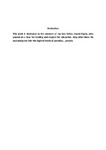The effect of dietary chromium(III) on growth and carbohydrate utilization in mirror and common carp (Cyprinus carpio) L.
| dc.contributor.supervisor | Davies, Simon J. | |
| dc.contributor.author | Ahmed, Arafat R. | |
| dc.contributor.other | Faculty of Science and Engineering | en_US |
| dc.date.accessioned | 2012-08-02T14:32:59Z | |
| dc.date.available | 2012-08-02T14:32:59Z | |
| dc.date.issued | 2012 | |
| dc.date.issued | 2012 | |
| dc.identifier | 10144072 | en_US |
| dc.identifier.uri | http://hdl.handle.net/10026.1/1091 | |
| dc.description.abstract |
The aim of feed formulation in aquaculture is to supply a suitable diet that provides nutritional requirements at relatively low cost. Carbohydrates are the most economic energy source for animals compared to protein and lipid; however, fish have limited capacity for dietary carbohydrate utilization. Trivalent chromium is an essential micronutrient for carbohydrate metabolism in vertebrates. The primary objective of this thesis was to enhance understanding of the effects of organic and inorganic forms of Cr on carbohydrate utilization, growth performance, gene expression and activity of specific key liver enzymes in carp Cyprinus carpio. In addition, effects of dietary Cr on body composition, Cr tissue content, blood cells DNA damage, and tissue histopathology (liver and gut) were evaluated. The first experiment (Chapter 3) tested levels of dietary Cr (0, 0.2, 0.5, 1.0, 1.5, 2.0 mg Cr kg-1 as Cr chloride) to determine Cr requirement; the second experiment (Chapter 4) compared bioavailability of different forms of Cr (Cr chloride, Cr picolinate, and Cr yeast); and the third experiment (Chapter 5) evaluated different levels of Cr yeast (0.5, 1.0, and 2.0 mg Cr kg-1) on utilization of a starch or dextrin-based diet. A Cr supplementation of 0.5 mg Cr kg-1 (regardless of form of Cr) produced highest growth performance; whereas 2.0 mg Cr kg-1 did not differ from control. The 0.5 mg Cr kg-1 also enabled carp to utilize complex carbohydrates (e.g., starch) and did not affect final body composition. Only 2.0 mg Cr kg-1 caused DNA damage in blood cells and tissue damage (liver and gut histopathology). Cr content in whole body increased with dietary Cr, but Cr did not affect hexokinase gene expression. Overall, results indicate that Cr can improve growth performance of carp and that Cr supplementation can enhance utilization of carbohydrates in fish feed. | en_US |
| dc.description.sponsorship | The Ministry of Higher Education and Scientific Research/ Republic of Iraq | en_US |
| dc.language.iso | en | en_US |
| dc.publisher | University of Plymouth | en_US |
| dc.subject | Carp, common and mirror | |
| dc.subject | Chromium | |
| dc.subject | Growth | |
| dc.subject | Carbohydrate | |
| dc.subject | Carbohydrate | |
| dc.subject | Body composition | |
| dc.subject | Enzyme | |
| dc.subject | Histology | |
| dc.subject | Nutrition | en_US |
| dc.title | The effect of dietary chromium(III) on growth and carbohydrate utilization in mirror and common carp (Cyprinus carpio) L. | en_US |
| dc.type | Thesis | en_US |
| dc.identifier.doi | http://dx.doi.org/10.24382/1376 |
Files in this item
This item appears in the following Collection(s)
-
01 Research Theses Main Collection
Research Theses Main


